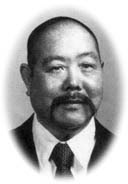
[photo of Zhang Zhaodong, Wang Shujin's teacher]
Empty Spirit; Raise Energy: Keep the head erect and straighten the back of the neck. The back of the head should float upward, but it should be held naturally. Keep your gaze level.
Contain Chest; Pull Up Back: Keep the upper body erect. Do not pull up the chest. Wrap the shoulders inward and round the back. The chest is held comfortably; the qi should flow easily.
Draw Together Lower Abdomen: The area below the navel (dan tien area) is a good place to accumulate qi. Keep the lower abdomen empty so qi can sink. This is not achieved by hollowing the abdomen but by turning the upper thighs slightly inward and dropping the coccyx, which draws the area in and down. This si also called, embracing the belly.
Breathe Slowly and Gradually: Breathe through the nose and do not use the mouth. The breath must be slow and even, like a cloud floating in the sky.
Coccyx Upright: From the neck to the tip of the coccyx, you must be extended and erect. This will allow the spinal nerves to function normally during exercise, and your reflexes will be unimpeded and lively.
Draw in Buttocks; Pull up Sphincter: Relax the lower back from the waist to the coccyx. The coccyx will naturally tuck inward as the buttocks are drawn down. You should have the intention of lightly contracting the area between the anus and the genitals.
Sink Shoulders; Drop Elbows: The shoulders have the feeling of being almost dislocated. The elbows hand downwards as if weighted. Only if the elbows will te shoulders be able to sink. In the way, qi will be allowed to penetrate to the fingers.
Tongue Touches Roof of Mouth: The tip of the tongue touches the roof of the mouth between the upper teeth and the hard palate. Close the mouth lightly and touch the teeth together. The tongue to the palate bridge allows the qi to flow without blockage. Pressing too hard with the tongue, clenching the teeth, or closing the mouth too tightly, will blunt qi.
The Six Utilities: The mind and yi (intention; conscious will); the yi and qi; the qi and li (muscular strength); the hand and feet; the shoulders and hips; Only when these six points are united and harmonious will your movements be connected as one.
The Yi is Commander and Chief: Movements of the internal martial arts are arrived at through the mind, and Bagua is no exception. Internal energy and external strength must act as one with one intent. “In movement seek stillness.”



























